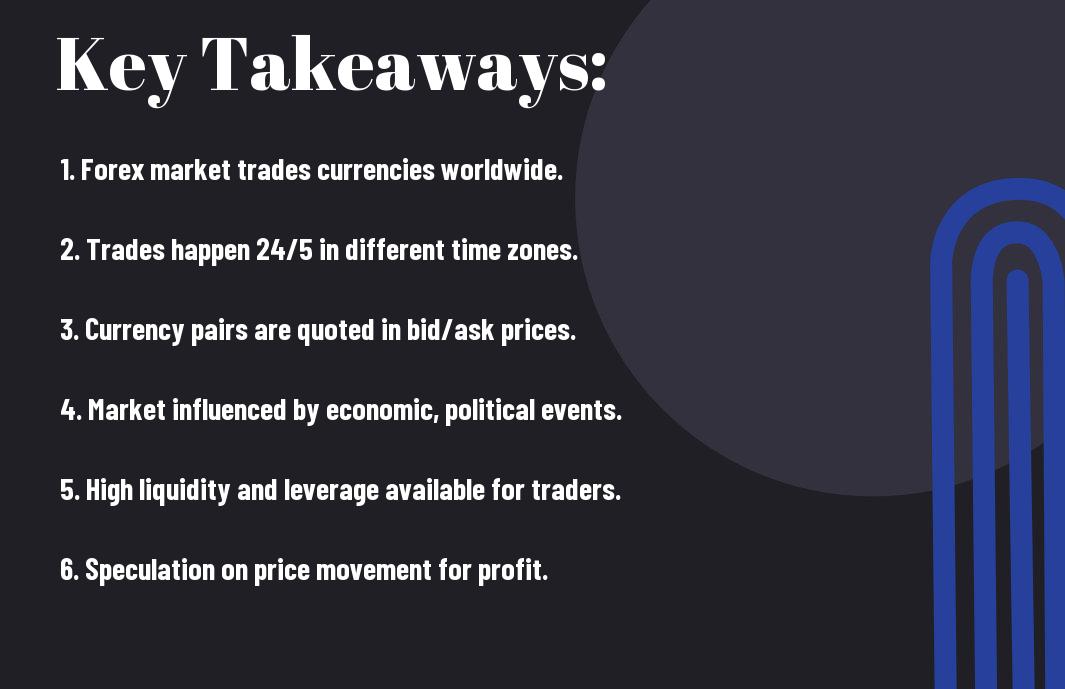Overseeing trillions of dollars in daily trades, the forex market is the largest and most liquid financial market globally. Understanding its mechanisms is crucial for anyone looking to trade foreign currencies effectively. In this comprehensive guide, we probe into the intricate workings of the forex market, from major players and currency pairs to the impact of geopolitical events. Whether you’re a seasoned trader or a novice looking to explore this dynamic market, this breakdown will equip you with the knowledge needed to navigate the complex world of forex trading.
Key Takeaways:
- Forex Market Basics: The forex market is a decentralized global marketplace where participants can buy, sell, exchange, and speculate on currencies. It is open 24 hours a day, five days a week, and it is the largest and most liquid financial market in the world.
- Mechanisms of Trading: In forex trading, currencies are traded in pairs, such as EUR/USD or USD/JPY. When trading forex, one currency is bought while another currency is simultaneously sold. Profits are made by buying a currency at a low price and selling it at a higher price, or selling a currency at a high price and buying it back at a lower price.
- Factors Influencing Forex Market: Various factors such as economic indicators, geopolitical events, central bank policies, and market sentiment can impact currency prices in the forex market. Traders use fundamental analysis, technical analysis, or a combination of both to make informed trading decisions.

The Main Players in the Forex Market
Major Currency Participants
Players in the forex market consist of various participants such as central banks, financial institutions, corporations, hedge funds, and individual traders. However, the major players in the market are central banks and financial institutions, which account for the majority of trading volume. Their large trade sizes significantly impact currency prices.
Role of Central Banks
One crucial player in the forex market is central banks. They play a pivotal role in influencing currency values through their monetary policies and interventions in the market. Central banks use their vast reserves to stabilize their domestic currency and regulate inflation, interest rates, and economic growth. Their actions can dramatically affect the exchange rate of a country’s currency.
Central banks also engage in forex trading to manage their foreign exchange reserves and intervene in the market to stabilize their currency during periods of volatility or speculation. These interventions can have significant impacts on currency values and market sentiment.
How Trades Are Made: Mechanics of the Forex Market
Currency Pairs and Pricing
Mechanics of the forex market start with understanding currency pairs and pricing. In forex trading, currencies are always quoted in pairs, such as EUR/USD or GBP/JPY. The first currency is the base currency, and the second is the quote currency. The price of a currency pair indicates how much of the quote currency is needed to purchase one unit of the base currency. For example, if the EUR/USD pair is trading at 1.1500, it means 1 euro can be exchanged for 1.15 US dollars.
The Process of Making a Forex Trade
With the process of making a forex trade, traders can enter the market by either buying or selling a currency pair. When a trader believes that the base currency will strengthen against the quote currency, they would buy the pair, known as going long. Conversely, if they anticipate the base currency to weaken, they would sell the pair, known as going short. The goal is to profit from the fluctuations in exchange rates between the two currencies.
Forex trading is highly volatile and risky, with leverage amplifying both gains and losses. It offers 24-hour trading five days a week, making it a liquid market with high trading volume. Traders must have a solid understanding of the market dynamics, risk management strategies, and technical analysis to succeed in the forex market.
Analysis and Strategy
Fundamental Analysis in Forex
Forex traders often use fundamental analysis to assess the intrinsic value of a currency. This type of analysis involves examining economic indicators, geopolitical events, and central bank policies that could potentially impact exchange rates. By understanding the underlying factors driving currency value, traders can make more informed decisions about when to buy or sell.
Technical Analysis and Charting
To navigate the dynamic forex market, traders rely on technical analysis and charting. This involves studying historical price data, patterns, and trends to identify potential entry and exit points for trades. This analytical approach helps traders gauge market sentiment, identify key support and resistance levels, and anticipate future price movements.
Plus, technical analysis tools like moving averages, Fibonacci retracements, and MACD can provide valuable insights into market dynamics. Traders use these tools to confirm trends, spot reversals, and manage risk effectively. However, it’s important to note that while technical analysis can be a powerful tool, it is not foolproof and should be used in conjunction with other forms of analysis for a comprehensive trading strategy.
Risks and Safety Measures
Your journey into the forex market comes with its own set of risks and challenges. It is crucial to understand these risks and be aware of safety measures to protect your investments and capitalize on market opportunities.
Understanding Leverage and Margin
Understanding leverage and margin is vital in forex trading. Leverage allows you to control a large position with a small amount of capital, increasing both potential profits and losses. Margin, on the other hand, is the amount of money required to open a position. It is important to use leverage and margin wisely to avoid significant losses that can wipe out your account.
Risk Management Strategies
One of the most important aspects of successful forex trading is implementing effective risk management strategies. Setting stop-loss orders, diversifying your investments, and avoiding overleveraging can protect your capital and minimize potential losses. Additionally, having a clear trading plan and disciplined approach can help you navigate the volatile nature of the forex market.
Another important risk management strategy is to regularly assess and adjust your risk tolerance and trading strategy. Markets can shift quickly, and being adaptable can help you stay ahead of potential risks and market volatility.
Final Words
Following this exploration of how the forex market works, it is evident that this dynamic and fast-paced market operates on the principles of supply and demand for different currencies. Understanding the factors that influence currency exchange rates and being knowledgeable about economic indicators, political events, and market trends can help traders make informed decisions. By staying informed, conducting thorough analysis, and managing risk effectively, traders can navigate the forex market with confidence and increase their chances of success.
FAQ
Q: What is the forex market?
A: The forex market, also known as the foreign exchange market, is where currencies are traded. It is a decentralized global marketplace where all the world’s currencies are traded. This market is crucial for international trade and investment.
Q: How does the forex market work?
A: The forex market operates 24 hours a day, five days a week, across different time zones. Participants, such as banks, financial institutions, governments, and individual traders, buy and sell currencies. Currency prices are determined by supply and demand forces.
Q: What influences exchange rates in the forex market?
A: Exchange rates are influenced by various factors, including interest rates, economic indicators, geopolitical stability, and market speculation. Central banks also play a significant role in determining exchange rates through monetary policy decisions.
